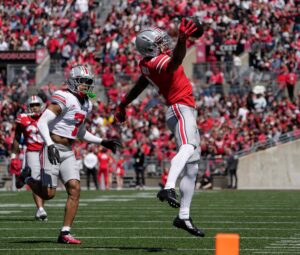Building the Mountaineers’ Future: Part Two
After eight games, we have seen bits and pieces of the Mountaineers’ new identity under Head Coach Neal Brown. The proverbial climb about which Brown regularly preaches remains a work in progress. Brown told us after the win over TCU, that the game put West Virginia football on full display. We started this series by looking at the running game and offensive line. Now, we take our second look at how Brown is building the Mountaineers’ future, this time focusing on the passing game.
What About the Air Raid?
After taking a look at the future of West Virginia’s run game in part one of this series, we shift gears and ask this question: what about the air raid? The truth is complicated. Brown does not run a true air raid offense. Indeed, he tailors his offense to his teams’ strengths, and he prefers a far more balanced approach offensively.
Undoubtedly, Brown employs plenty of air raid concepts. Of course, he puts a lot more window-dressing on it to keep defenses off-balance. Thus, mixed with the standard spread-iso, mesh, and screenplays, Brown will also throw out plenty of power-I formations and run between the tackles.
That does not mean Brown doesn’t want to move the ball down the field. His offenses still take plenty of shots down the field. And when the run game does not work, Brown will dial-up plenty of passes. Against Texas, for example, when Leddie Brown suffered an early in-game injury, West Virginia threw the ball 50 times.
2019: Replacing Potency
Similar to the story along the offensive line, Brown stepped into an offense that sought to replace most of its aerial production. Will Grier graduated, leaving two sparsely-used quarterbacks–Jack Allison and Austin Kendall–to compete for the starting nod. At the time, Jarret Doege was not ready, as he dealt with injuries much of fall camp. Tight end Trevon Wesco also graduated, leaving the Mountaineers down a significant weapon there.
As for the wideouts, David Sills and Gary Jennings graduated. And then West Virginia lost Marcus Simms due to academic issues. The only significant returning production came from T.J. Simmons. As a result, the Mountaineers relied on Florida State transfer George Campbell, Simmons, and a group of freshmen to lead its aerial attack.
The result was predictable. West Virginia averaged under 250 passing yards per game for the first time since 2010. But that did not come without good news. Doege stepped in for the last three-and-a-half games and injected some life into the offense. Sam James, Sean Ryan, Ali Jennings, and Bryce Ford-Wheaton all showed promise at various points in the season.
2020: Taking a Step Forward?
Through eight games, West Virginia has increased its passing efficiency. They average 286 yards a game through the air. And Doege, for the most part, has secured the ball well and minimized turnovers. While still inconsistent, Doege has large stretches where he displays poise and accuracy. However, on the other side of his throws, we see mixed results.
Winston Wright has emerged as a consistent threat, leading the receivers with 42 receptions and 494 receiving yards. Jennings made the most of his increasing opportunities. Simmons took control of the game in the win over TCU. And Ford-Wheaton and James still flash plenty of upsides. Yet, both of those receivers, still suffer from a high drop rate. Simply, too many catchable balls fall to the turf on their watch.
All in all, the results in 2020 have been mixed while the momentum favors continued improvement. Neither drops by the receivers nor inconsistency by Doege became issues against TCU. If the unit plays like that over the next two games, West Virginia has a realistic opportunity to add one or two more wins to its 2020 totals.
2021: Building the Mountaineers’ Future
After the season, the Mountaineers lose only a small portion of their 2020 production. Doege will be back. Freshman Garrett Greene should continue to develop. And Will Crowder will join the fray after signing day.
Simmons could come back (given the extra year of eligibility the NCAA granted all players), and he could definitely benefit from an extra season. Most of the remaining receivers will return as well, though we could easily see at least one outbound transfer given the crowd growing in the room. Isaiah Esdale has made a recent splash displaying sure hands in traffic. Wright will only improve with more experience. Jennings also appears sure-handed. James may be the fastest of the bunch, and, if he improves his focus and drops fewer passes, he still has a bright future. As does Ford-Wheaton. We haven’t yet heard much from Randy Fields, but he is only a sophomore.
This group does not even account for the trio of freshman wideouts. The Mountaineers fought off interest from several schools to land Sam Brown late in the cycle. Devell Washington has the makings of an outstanding possession receiver. While Reese Smith has already shown some of those traits on the field. West Virginia should also add current four-star commit Kaden Prather and three-star Davis Mallinger to the mix next year.
West Virginia also adds a pair of tight ends. That is a lot of mouths to feed, but we know Brown rewards effort and looks to polish players through adversity. Ultimately, several standout players will emerge from this group that features balanced depth across several classes. As a result, West Virginia should not suffer in the near future after seeing nearly all of its production evaporate overnight.
One thing is sure, the foundation is there. How the players will build from here remains to be seen.






